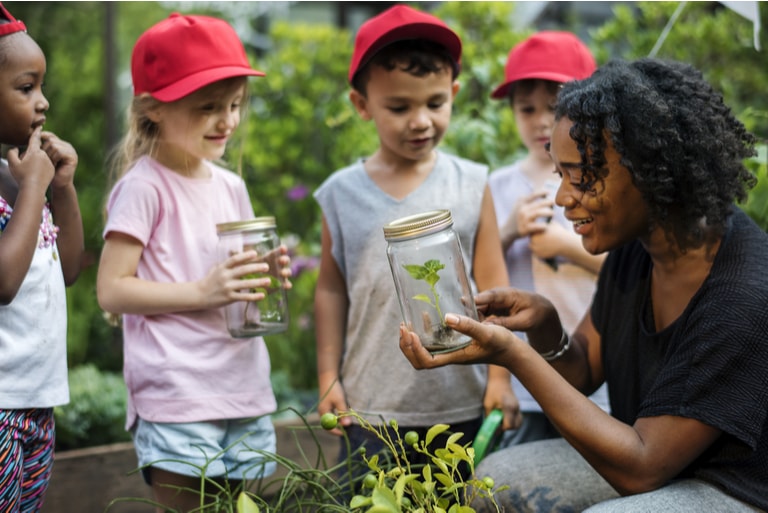By Karen Sieber, University of Maine
A few years ago, at a junk shop, I stumbled on an ornate green scrapbook- “Omnibus College: America’s College on Wheels,” read the cover. Flipping through its pages, lovingly curated by Alyce M. Peterson of Pocatello, Idaho, a 1933 student of the college, made me wish I’d been an Omnibuster, as students called themselves.
The brainchild of William M. Goldsmith, a biology professor, the Omnibus College operated from 1922 to 1935. Taught by faculty drawn from universities and public school districts from across the country, students could earn college credit in a range of subjects, including biology, American history, and sociology. Run under the umbrella of Wichita Municipal University (now Wichita State University), by the late 1920s the college involved a two-month long excursion to historic sites, cities, natural wonders, and cultural institutions nationwide. It became so popular that Goldsmith had to increase to three staggered tours each summer to keep up with demand. A brochure mentions starting points in over a dozen states where students could join the caravan.

Ninety percent of the students were women, who came predominantly from the Plains states. Many were or aspired to become schoolteachers, and many likely joined after reading articles about the college in the news or hearing about it from friends who were past Omnibusters. As the Salt Lake Tribune reported in 1933, the students also produced a newspaper, the Omnibuster, and distributed 50,000 copies nationwide every summer in locations they visited.
Although a handful of copycat institutions operated at the time, none reached the scale or popularity of the Omnibus College. The elaborate tours required a fleet of vehicles. The students traveled on five or six actual omnibuses, followed by trucks carrying luggage, camping equipment, full kitchens, and staff members to keep the venture moving. Students would travel to a new destination nearly every day, driving and taking field trips during the day. At night, scrapbook photos reveal, staff would lecture by fireside, followed by sing-alongs or visits from local performers. This opportunity to broaden knowledge and explore the country was a kind of freedom few women were afforded at the time.
Although a handful of copycat institutions operated at the time, none reached the scale or popularity of the Omnibus College.
Peterson’s scrapbook—filled with ephemera from her Omnibuster education—offers a glimpse into the students’ journeys. She wrote for her hometown paper along the way, and included her articles and photographs in the scrapbook. Pasted among her words and images are school reports on the Justice Taney home and the environmental history of Muscle Shoals; perfectly wound yarn samples from textile mills; tickertape from a visit to Wall Street; brochures for places like the Shiloh Battlefield, the Empire State Building, and Plymouth Rock; birch bark and pressed leaves (miraculously still green) from field trips into the Maine wilderness; photos of immigrant children in New York and sharecroppers’ children in Mississippi, alongside candid shots of fellow students in their downtime at camp; and sing-along books with songs for every state she passed through.
Today’s students would almost certainly benefit from a similar learning environment. As Roy Rosenzweig and David Thelen’s landmark study The Presence of the Past (1998) revealed, the majority of Americans feel more connected to the past when talking with people who have experienced it, or by visiting historic sites and museums, than they do from reading a book or learning in a traditional classroom environment. To be sure, the students of 2019 would have a different experience than Peterson did in 1933. Given the demographic changes that have taken place in higher education, students would probably be more diverse in their racial, gender, class, and geographic makeup, with a far smaller percentage of teaching majors. And instead of keeping scrapbooks, students would probably be collecting Instagram-worthy “experiences.”

But in many ways, students would probably still relate to what and how the Omnibusters were learning. Whereas Omnibusters, scrapbooks reveal, could earn credits in journalism by documenting their trip for the Omnibuster, today’s students could do something similar by continually updating a YouTube channel or an Instagram feed: a project incorporating elements of the digital humanities, journalism, social media marketing, and public history. What matters most in promoting student learning in an alternative classroom setting like this is what John Dewey called the “experiential continuum”—that is, building on previous experiences to better understand newer experiences. By connecting interdisciplinary learning experiences and extending the field trip from the usual few hours into a two-month-long endeavor, Goldsmith’s Omnibus College neared this elusive experiential continuum. And Dewey’s idea, in principle, still seems within reach today.
From a practical standpoint, of course, actually recreating the full Omnibus College experience would be a long shot. Logistics and institutional approval aside, the cost alone would be prohibitive for most students. According to a college brochure, the entire tour in 1933, including travel, tuition, food, lodging, and entrance fees, cost roughly $175 (a little over $3,000 today). But the same type of engagement and experience is possible through other routes. For educators who can’t offer field trips because of geography, time limits, or a lack of funds, digital tools like Google Earth, Google Street View, YouTube, and the Clio app can allow students to visit places all around the country (and world) right from the classroom.
The more I dig into the scrapbooks and writings of Omnibusters, the more I wonder if we could create a similar educational experience that would foster this kind of excitement and lifelong engagement. In a world of declining humanities majors, creating a new learning model built on experience could connect our discipline to the next generation of historians and critical thinkers, hungry for knowledge. As Alyce Peterson would tell us, not all learning need take place in a traditional classroom.
Karen Sieber works as the humanities specialist for the McGillicuddy Humanities Center at the University of Maine. She also serves as the research and outreach coordinator for the Theodore Roosevelt Center and Digital Library.
Note: The views expressed in this article are the author/s, and not the position of Intellectual Dose, or iDose (its online publication). This article is republished from Perspectives on History under a Creative Commons license.



